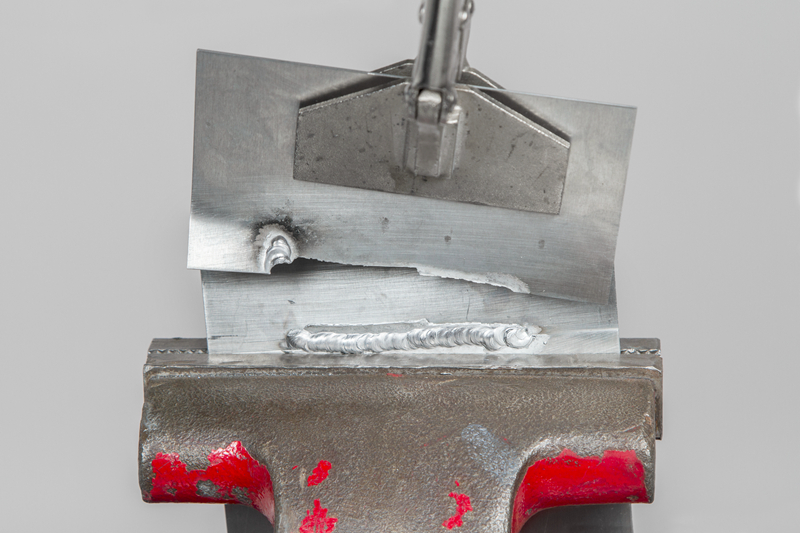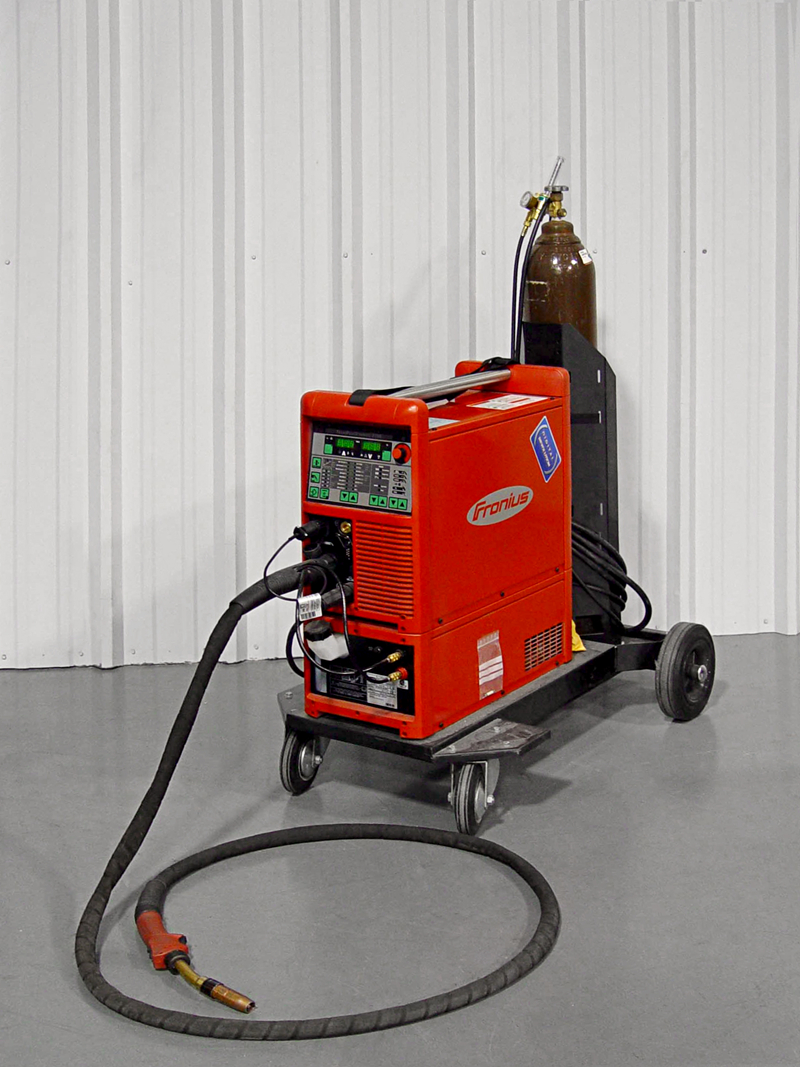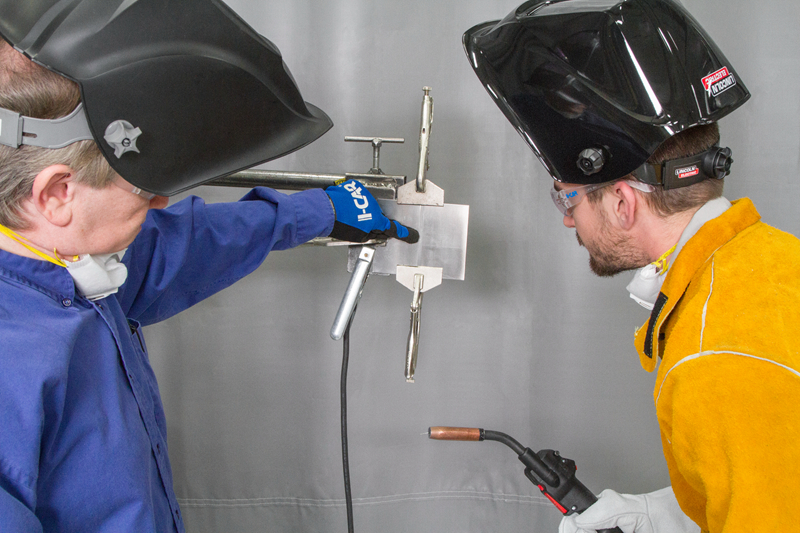 钢焊接采用MAG保护气体,而铝焊接采用的是MIG气体,这要求技术人员掌握一些新技术。
钢焊接采用MAG保护气体,而铝焊接采用的是MIG气体,这要求技术人员掌握一些新技术。 I-CAR的产业技术关系总监Jason Bartanen
I-CAR的产业技术关系总监Jason Bartanen 采用MIG气体进行铝焊接,比如搭接焊中的这个填角焊缝,应始终在与车身焊接之前进行外观查验和破坏性检查。
采用MIG气体进行铝焊接,比如搭接焊中的这个填角焊缝,应始终在与车身焊接之前进行外观查验和破坏性检查。 通常建议使用MIG脉冲喷射过渡焊接设备进行铝焊接操作。
通常建议使用MIG脉冲喷射过渡焊接设备进行铝焊接操作。 I-CAR铝焊接培训与认证项目采用现场讲解方式,由I-CAR的铝焊接专家进行指导授课。
I-CAR铝焊接培训与认证项目采用现场讲解方式,由I-CAR的铝焊接专家进行指导授课。
汽车设计师和制造商的首要目标是找到提升燃油经济性的方法,这个任务如今变得越来越复杂。美国法规要求,所有汽车制造商都要在2025年前达到54.5 mpg的CAFE(公司平均燃料经济性)标准。这一标准要求的巨大提升,在以前看来是不切实际,也不可能实现的,但现在却是汽车制造商必须达成的目标。
为了应对排放法规的要求并迎合消费者偏好,汽车制造商们开展了一个“技术海啸”(Technical Tsunami)运动——变革的大潮催生了许多新技术和新材料的应用,如金属铝、金属镁、碳纤维、先进高强度钢,以及先进的车辆电子装置的广泛采用。许多新材料和新技在汽车中的应用,都需要进行专门的维修培训与之配合。仅在2015年,汽车制造商就推出了142款新车型,其中包括全新设计的,也包括现有车型的升级改造版。
与以往的车型相比, 2015款福特F-150车型大量使用了铝材料,实现减重318 kg(700 lb)。福特的F-150是享誉全美的畅销车型之一,其使用材料的重大调整引起了汽车行业的广泛重视。
铝制车辆的维修安全性标准
汽车架构中采用的铝制材料越来越多,领先的汽车厂商也认识到,为了保证汽车在使用大量铝材料后的安全性,除了制造工艺外,还必须审慎考虑汽车维修维护方面的问题。技术人员必须明确了解如何使用碰撞修护设备,以便充分、安全、高质量地完成铝架构的维修维护。
在整个汽车行业内,技术人员正在学习必要的铝制车身维修新技术,这也是I-CAR焊接培训与认证(I-CAR Welding Training & Certification)课程的内容之一。
在F-150车型上市之前,I-CAR就与福特汽车合作,为碰撞维修技术人员开设了I-CAR培训课程。而在此之前,业内的常规做法都是先发布新车,再进行相关维修培训。F-150的车辆架构维修培训课程FOR06已成为I-CAR历史上最受欢迎的课程之一。该课程的特色是重点培训适用于铝制车身的焊接、铆接,以及冲铆-粘接技术。
铝焊接——难度不大,但工艺不同
铝焊接本身并不比钢焊接难多少,但需要在许多方面采取不同的做法。
建立操作区——汽车制造商建议的最佳做法之一是,将铝制车辆维修区与钢材料焊接区分开。原因是空气中的钢材料微粒会污染铝材料,如果长时间接触水,也可能会导致腐蚀。
设备——技术人员普遍采用MAG(金属活性气体)焊接法对钢制车身进行维修,这需要使用一种由75%的氩气和25%的二氧化碳混合而成的保护气体,即“C-25”混合气体。与此不同的是,铝材料需要使用MIG(金属惰性气体)焊接法,保护气体100%为氩气。
使用氩气是因为这种气体有助于焊接金属表面的净化。当焊接表面接触到空气时,铝材料会立刻形成一层较薄的氧化铝。氧化铝的熔点是2050°C(3725°F),远高于金属铝熔点650°C(1200°F),因此必须将氧化铝清理干净,否则焊接就只能透过氧化铝涂层进行,这会使得焊接效果大打折扣。
技术人员应使用铝材料专用的焊接导电嘴,中间的焊丝通道也应更大。专用焊枪上应刻有“A”或“AL”的字样。此外,铝焊接所使用的保护气体喷孔也必须大于钢焊接,以便供应更大的保护气流。
为了避免钢材料颗粒污染金属铝表面,铝和钢材料加工也会使用不同的手动工具。铝材料应配有专门的切割工具和研磨工具,以避免与钢材料发生交叉污染。
准备工作——在开始焊接铝之前,技术人员需要清除所有的表面涂层,之后再用特殊溶剂擦拭干净,目的是清除所有的表面污染物。技术人员需要用砂纸或不锈钢刷子清除焊接区域的氧化铝,在即将开始焊接操作前还需再次进行清理。
焊接技巧——铝焊接的技巧与钢焊接不同,技术人员应该用“推”的方式进行铝焊接,而不是“拉”的方式。这种方法可以增强保护气体的应用效果,有助于更好地将氧化铝清除干净。
此外,在铝焊接中,焊丝需要与焊炬保持较远距离,而焊炬需要离焊接表面更远。须注意的是,技术人员应使用汽车厂商推荐的焊丝。
铝焊接通常比钢焊接需要更大的电流,并且焊接中的金属过渡形式也有所不同。钢焊接通常使用短路过渡法,当焊丝接触到钢时,会发生短路和爆断。而在铝焊接中,最好的方法是脉冲喷射过渡,在焊珠喷进熔池之前就会爆断。
钢焊接时,焊炬的热量通常会集中在一个区域,而铝材料会将热量传递到整个部件。因为铝的热传递效率更高且熔点更低,因此焊接动作应该先慢后快,而焊炬在部件上移动时,速度应该更快。
为了避免铝焊接开始时温度过低,技术人员需要使用引弧板(run-on tab),或具有预热功能的设备。在焊接收尾时,在金属铝表面往往会形成弧坑,因此技术人员需要在收弧时通过额外动作将弧坑引至焊件外,或者使用引弧板将其引出。
技术新前沿:下一步会是什么?
为了应对未来的诸多挑战,我们需要合适的设备和充分的培训,以及勤奋好学、技术过硬的维修人员。汽车行业正在发生巨大改变,因此碰撞维修行业必须培养脚踏实地、乐于学习的文化,将技能学习和知识掌握视为战略性资产的积累,对其进行妥善的管理、促进和保持。
明确了未来发展的核心要务,我们也就准备好了采用铝焊接的新技术,并建立起更加卓越的方法架构,将来无论出现怎样颠覆性的材料应用或创新技术,我们都可以有办法应对。
文章来源:《汽车工程杂志》。本文作者是I-CAR的产业技术关系总监Jason Bartanen。I-CAR是一个非盈利性机构,主要进行教育培训、知识积累与解决方案开发,旨在满足碰撞维修产业不断变化的需求。
作者:Jason Bartanen
来源:SAE《汽车工程杂志》
翻译:SAE上海办公室
Aluminum welding: The next frontier for technicians
For automotive designers and manufacturers, finding ways to increase fuel economy has become a primary—and increasingly complicated—goal. In the U.S., regulations now focus on a requirement that every automaker achieve a corporate average fuel economy (CAFE) of 54.5 mpg by 2025. Such dramatic improvements once seemed impractical or impossible, but today they are the new reality for automakers.
In response to these emissions regulations and to the evolving preferences of consumers, automakers have generated a “Technical Tsunami”—the waves of change resulting in new technologies and new materials like aluminum, magnesium, carbon fiber, advanced high-strength steels, and vehicle-wide proliferation of advanced electronics. Many of these require specialized training to repair. In 2015 alone, automakers introduced 142 new or redesigned vehicle models.
The aluminum-intensive 2015 Ford F-150 shed 700 lb (318 kg) compared with previous models. The drastic material change to the F-150, with its longstanding reputation as one of America’s best-selling vehicles, caused the industry to stand up and take notice.
Maintaining a standard of vehicle repair safety with aluminum
As progress has been made toward adopting aluminum for automotive structures, industry leaders have realized that, to keep aluminum vehicles safe, they must consider not just their manufacturing process but also their repair. Collision repair facilities needed to be confident that their technicians knew how to properly achieve complete, safe, and quality repairs on aluminum structures.
Technicians across the industry are learning the necessary new methods for working with aluminum as part of the I-CAR Welding Training & Certification program.
Prior to the launch of the F-150, I-CAR and Ford Motor Co. worked together to create and make an I-CAR training curriculum for collision repair technicians. Historically, vehicles debut before the training begins. The F-150 structural repair training course FOR06 has become one of the most popular courses in I-CAR’s history. In particular, the program emphasizes processes for welding, riveting, and rivet bonding aluminum vehicles.
Welding aluminum—not difficult, just different
Welding aluminum is not more difficult than welding steel, but it requires a different mindset in a number of areas.
Setup space—One best practice that is often recommended by vehicle makers when repairing aluminum vehicles is to set up an environment separate from the steel welding area. The concern is that steel particles in the air could contaminate aluminum and possibly cause corrosion if exposed to water over time.
Equipment—When repairing steel bodies, technicians commonly employ MAG (metal active gas) welding, using a shielding gas that is 75% argon and 25% carbon dioxide—a mixture known as C-25. Aluminum, however, requires the use of MIG (metal inert gas) welding with a shielding gas composed of 100% argon.
Argon is specified because it offers good cleaning action on the metal being welded. Aluminum materials immediately form a thin coat of aluminum oxide on their surfaces when exposed to air. Moreover, aluminum oxide melts at 3725°F (2050°C), while aluminum itself melts at 1200°F (650°C), so the aluminum would melt before its oxide covering does. The aluminum oxide must be removed, or the technician will be trying to weld through it, which is certain to produce a less-than-desirable weld.
Technicians should use contact tips specifically designed for aluminum, with an oversized hole for the electrode wire. These tips are stamped with an “A” or “AL.” Similarly, shielding gas nozzles must be larger than those used with steel to accommodate the increased gas flow.
Further, to avoid contaminating aluminum surfaces with steel particles, separate hand tools are often used. Cutting tools and abrasives should be dedicated specifically to aluminum as well to avoid cross-contamination.
Preparation—Before starting to weld aluminum, technicians need to remove any coatings from the surface and then wipe it clean with a solvent to eliminate any surface contamination. They should use sandpaper or a stainless steel brush to remove the aluminum oxide from the weld zone and clean the area again immediately before the welding operation begins.
Technique—Creating welds with aluminum differs from working with steel. Technicians should use the push technique, rather than the pull technique. This method enhances the ability of the shielding gas to clear aluminum oxide from the aluminum.
Also, the electrode wire should stick out farther from the welding torch, and the torch should be held farther back from the welding surface. Note that the technician should always use the electrode wire recommended by the vehicle maker.
Typically, more amperage is required for welding aluminum than for steel, and the welding transfer method is different. When working with steel, generally the short-circuit method is employed so that, when the electrode hits the steel, it short circuits and breaks off. For aluminum, however, the preferred transfer technique is a pulsed spray in which the weld bead breaks off before it is sprayed into the molten puddle.
Whereas steel holds heat from the welding torch in one area, aluminum transfers the heat throughout the part. Because of this greater heat transfer efficiency and aluminum’s low melting point, the welding speed should start slowly but then increase as the welding torch moves across the panel.
To avoid cold starts with aluminum, the technician should create a run-on tab or use a machine with a pre-heating feature. At the end of the weld, craters tend to form in aluminum, so the tech should activate an extra trigger pull when completing the weld, or make a run-off tab.
The new frontier: What’s next?
To master the curves in the road ahead, we need the right equipment, training, and qualified technicians—along with an appetite for learning. Given the dramatic changes in vehicles, it is imperative that the collision repair industry support a robust and earnest “Learning Culture,” building businesses that treat learning and knowledge as strategic assets that need to be managed, developed, and maintained.
Once we understand the nature of this new road, we’ll be prepared to enter the new frontier of aluminum welding, building an even better framework for approaching whatever game-changing material or innovation is sure to be down the road.
Jason Bartanen, Director of Industry Technical Relations for I-CAR, wrote this article for Automotive Engineering. I-CAR is a not-for-profit education, knowledge, and solutions organization designed to support the evolving needs of the Collision Repair Inter-Industry.
Author: Jason Bartanen
Source: SAE Automotive Engineering Magazine
等级
打分
- 2分
- 4分
- 6分
- 8分
- 10分
平均分
